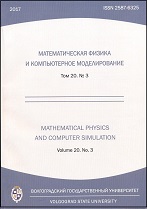|
This article is cited in 1 scientific paper (total in 1 paper)
Mathematics
On the structure of the space of linear sistems of differential equations with periodic coeffiсients
V. Sh. Roitenberg
Yaroslavl State Technical University
Abstract:
We examine linear systems of differential equations
$$
l: \dot {x}_i = \sum_{j=1}^{n} a_{ij}(t) x_j + b_j(t), i=1,\ldots,n
$$
with continuous $\omega$-periodic coefficients. The system $l$ induce the autonomous system $l_p: \dot {x}_i = \sum_{i=1}^{n} a_{ij}(s) x_j + b_j(s), \dot s = 1$ on ${\mathbf{R}}^n \times \mathbf{S}^1$, where $\mathbf{S}^1 = \mathbf{R}/\omega \mathbf{Z}$. The system $l_p$ has the unique extension $\overline{l}_p$ on ${\mathbf{RP}}^n \times \mathbf{S}^1$. By trajectories of system $l$ in ${\mathbf{R}}^n \times \mathbf{S}^1$ (${\mathbf{RP}}^n \times \mathbf{S}^1$) we will mean trajectories of system $l_p$ ($\overline{l}_p$). Let us consider linear systems $l$ as elements of Banach space $L S^n_{\omega}$ of continuous $\omega$-periodic functions $(a_{11}, \ldots, a_{nn}, b_1,\ldots,b_n)\colon \mathbf{R} \to \mathbf{R}^{n^2+n}$ with norm $\|l\|:=\max_{i,j}\max_{t}\max {|a_{ij}(t)|,|b_i(t)|}$. The system $l \in L S^n_{\omega}$ is said to be structurally stable in ${\mathbf{R}}^n \times \mathbf{S}^1$ (in ${\mathbf{RP}}^n \times \mathbf{S}^1$) if $l$ has a neighborhood $V$ in $l \in L S^n_{\omega}$ such that for any system $\widetilde{l} \in V$ we may find a homeomorphism $h \colon {\mathbf{R}}^n \times \mathbf{S}^1 \to {\mathbf{R}}^n \times \mathbf{S}^1$ ( $h \colon {\mathbf{RP}}^n \times \mathbf{S}^1 \to {\mathbf{RP}}^n \times \mathbf{S}^1$, $h (\mathbf{R}^n \times \mathbf{S}^1) = \mathbf{R}^n \times \mathbf{S}^1$) which maps oriented trajectories of system $\widetilde{l}$ onto oriented trajectories of system $l$.
Let $\Sigma_0 L S^n_{\omega}$ be the set of systems $l \in L S^n_{\omega}$ whose multiplicators do not belong to the unit circle.
Theorem 1. The set $\Sigma_0 L S^n_{\omega}$ is open and everywhere dense in $L S^n_{\omega}$ . A system $l \in L S^n_{\omega}$ is structurally stable in $\mathbf{R}^n \times \mathbf{S}^1$ if and only if it belong to the set $\Sigma_0 L S^n_{\omega}$.
Let $\Sigma L S^2_{\omega}$ be the set of systems $l \in L S^2_{\omega}$ whose multiplicators are real, distinct and different from $-1$ and $1$. Let $\Sigma^{+}_s$, $\Sigma^{-}_s$, $\Sigma^{+}_{ns}$, $\Sigma^{-}_{ns}$, $\Sigma^{+}_{nu}$ and $\Sigma^{-}_{nu}$ be subsets of $\Sigma L S^2_{\omega}$ consisting of systems $l$ with multiplicators $\mu_1$, $\mu_2$ for which $\mu_1 < 1 < \mu_2$ ( $\mu_2 < -1 < \mu_1$) if $l \in \Sigma^{+}_s$ ($l \in \Sigma^{-}_s$) , $0 < \mu_1 < \mu_2 < 1$ ( $ -1 < \mu_1 < \mu_2 < 0$) if $l \in \Sigma^{+}_{ns}$ ($l \in \Sigma^{-}_{ns}$), $1 < \mu_1 < \mu_2$ ( $\mu_1 < \mu_2 < 1$) if $l \in \Sigma^{+}_{nu}$ ($l \in \Sigma^{-}_{nu}$).
Theorem 2. 1) A system $l \in L S^2_{\omega}$ is structurally stable in $\mathbf{RP}^2 \times \mathbf{S}^1$ if and only if it belong to the set $\Sigma L S^2_{\omega}$. 2) For any system $l \in \Sigma L S^2_{\omega}$ the corresponding system $\overline{l}_p$ in $\mathbf{RP}^2 \times \mathbf{S}^1$ is a Morse–Smale system. 3) The sets $\Sigma^{+}_s$, $\Sigma^{-}_s$, $\Sigma^{+}_{ns}$, $\Sigma^{-}_{ns}$, $\Sigma^{+}_{nu}$ and $\Sigma^{-}_{nu}$ are classes of topological equivalence in $\Sigma L S^2_{\omega}$.
The paper also describes bifurcation manifolds of codimension one in the space $L S^2_{\omega}$.
Keywords:
linear periodic systems of differential equations, projective plane, structural stability, bifurcation manifolds, multiplicators.
Citation:
V. Sh. Roitenberg, “On the structure of the space of linear sistems of differential equations with periodic coeffiсients”, Vestnik Volgogradskogo gosudarstvennogo universiteta. Seriya 1. Mathematica. Physica, 2017, no. 1(38), 13–21
Linking options:
https://www.mathnet.ru/eng/vvgum159 https://www.mathnet.ru/eng/vvgum/y2017/i1/p13
|

|




 Contact us:
Contact us: Terms of Use
Terms of Use
 Registration to the website
Registration to the website Logotypes
Logotypes








 Citation in format
Citation in format 
